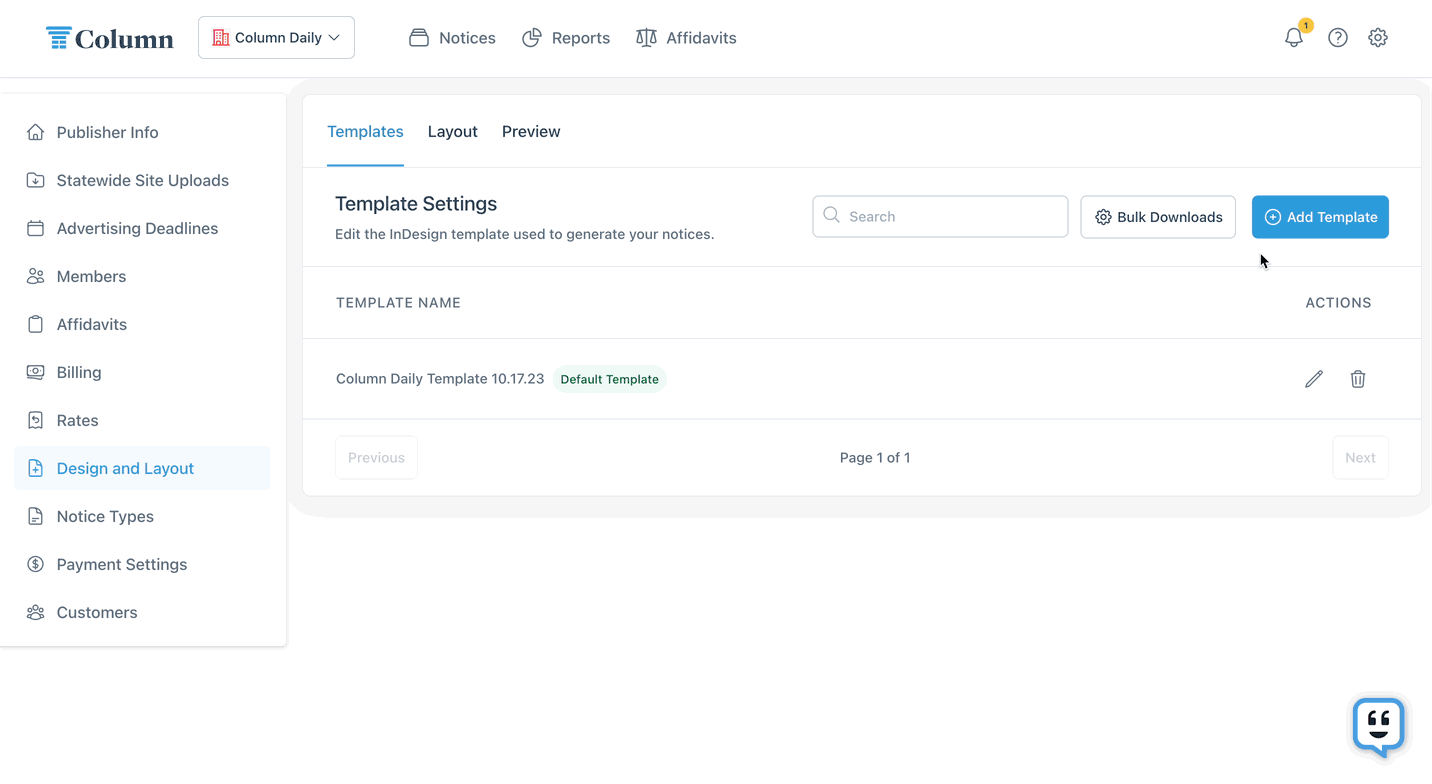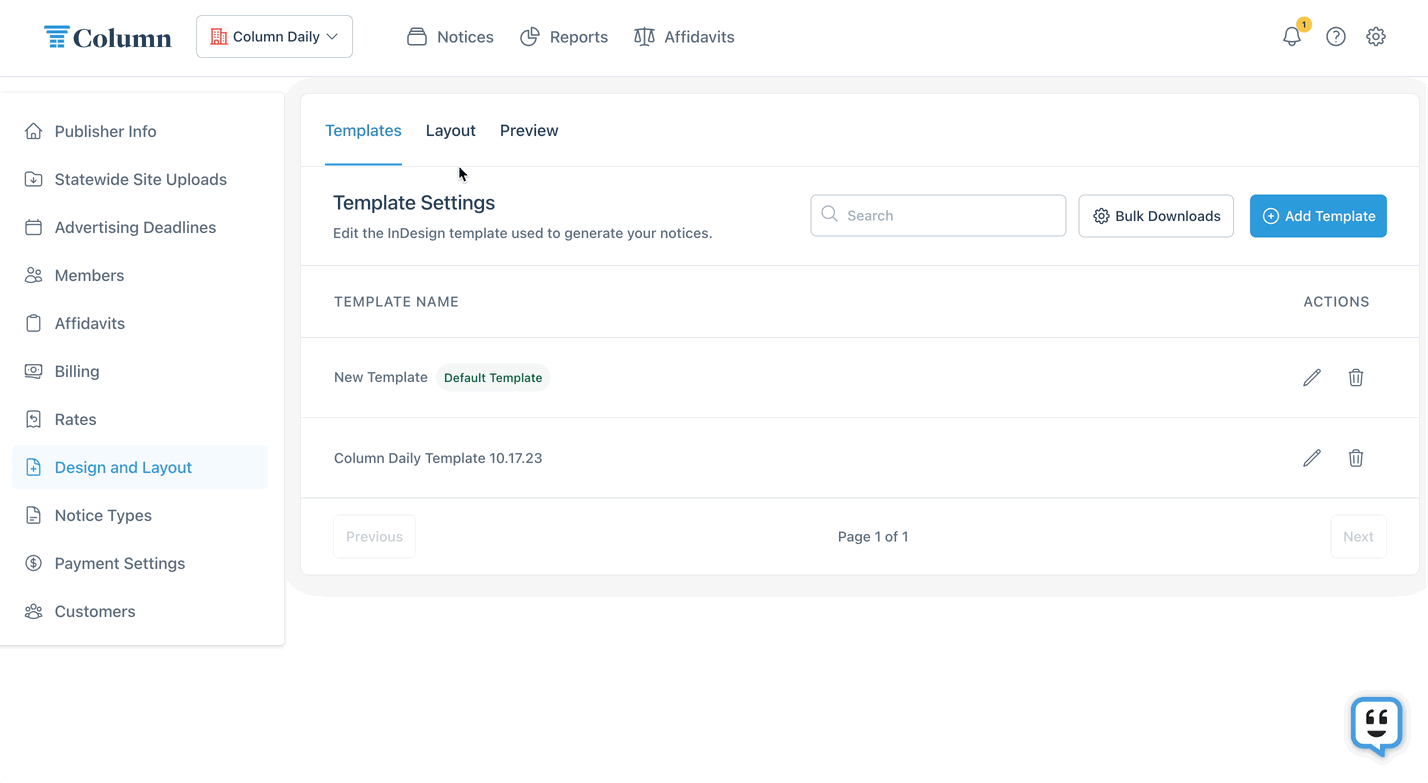How do I manage my newspaper's design and layout settings?
In My Organization > Design and Layout, you can configure the layout and formatting of notices in your publication. This section includes useful features such as InDesign templates, notice headers/footers, and file upload options. Design and Layout consists of three tabs:
Templates — Create and manage InDesign templates for your notices. Column uses InDesign templates to create print-ready notices based on your publication's style preferences.
Layout — Configure formatting settings, including headers/footers, notice sizes, borders, and file upload options during notice placement.
Preview — Use our preview tool to see how notices will look using your publication's InDesign template(s) and formatting settings.
The rest of this article contains a more detailed breakdown of what you can do in each of these tabs.
Templates
In this tab, you can create InDesign templates for your notices. Every publication is required to have one default template, but you can also assign templates to specific notice types if different notice types require different styling. For now, the Column team can help you assign custom templates to notice types.
To create a new template:
Click "Add Template."
Give the template a name.
Download the sample template to use as a base.
Adjust styles in InDesign until the IDML file matches your publication's desired formatting.
Re-upload the completed file. In the right-hand preview, you can review the styles Column found in this file to make sure everything matches your expectations.
If you want new notices to automatically use this template, make this template your publication's default template. Note: Setting a new template as the default does not automatically update existing notices.
Click "Save," and you're done!
If your publication uses bulk download to paginate notices into a combined IDML file, click "Bulk Downloads" to manage your bulk download template(s).
Layout
This tab contains many settings, organized by category, that affect how notices will appear in your publication.
Headers and Footers:
You don't have access to edit this section, because many headers and footers require advanced setup by the Column team.
Headers and footers appear at the top and bottom of notices in your publication. Column can configure these to include publication dates and other custom information about specific notices.
Default headers and footers apply for notices that have multiple publication dates. One-run headers and footers apply for notices that have only one publication date. This is useful if you display publication dates differently depending on whether a notice has one or multiple dates.
Notice Sizes:
You can set column width ranges for liner and display notices. The maximum width supported in Column is 12 columns.
If you set a default column width, that width will be automatically selected when placing notices, unless the user selects a different width or the notice type has been assigned a different width.
If you set a maximum notice length, users will encounter an error when placing a notice that exceeds the specified length, and they'll be forced to shorten their notice.
Borders:
This feature simply adds a basic black border around notices — liners, displays, or both.
At this time, you cannot configure the weight or color of borders.
File Uploads:
These settings control what happens when users upload files in the Create Notice step of placement.
For display notices: You can disable display notices, or allow only display notices. You can also grayscale all displays (i.e. make them black and white).
For liner notices: You can allow images in liner notices. You can also disable tables, which strips formatting to place all table content in one column.
You can allow customers to submit multiple files. If given this option, customers will also be able to leave notes about how they want their files formatted. The publisher is responsible for turning all uploaded files into a publication-ready notice and then uploading that notice back into Column.
Preview
In this tab, you can control several inputs to see what notices will look like using your publication's templates and formatting settings. Column provides sample notice text with multiple paragraph styles, which you can use to make sure your InDesign template is configured correctly.


